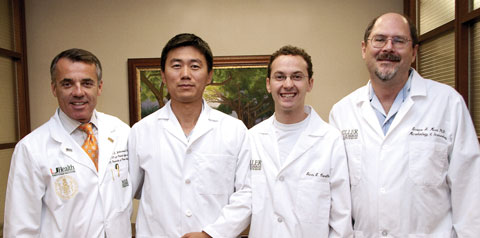 |

|
Published Research Furthers
Understanding of Kaposi’s Sarcoma
Study suggests antioxidants to combat disease
Antioxidant therapy could help prevent and treat Kaposi’s sarcoma, a major AIDS-related malignancy, according to Miller School research published in Proceedings of the National Academy of Sciences. Even though it’s known that the human herpesvirus 8 is responsible for Kaposi’s hallmark skin and mucosal lesions, making it a class of tumors induced by a viral infection, the molecular mechanisms have remained an enigma. And while highly active antiretroviral therapy has reduced the number of cases, Kaposi’s sarcoma still has a high death rate, particularly in Sub-Saharan Africa.
 |
| From left, Dean Pascal J. Goldschmidt, M.D., and Kaposi’s sarcoma researchers Qi Ma, Ph.D., Lucas E. Cavallin, and Enrique A. Mesri, Ph.D. |
Scientists at Sylvester Comprehensive Cancer Center and other collaborating universities have reproduced Kaposi’s sarcoma in mice
by overexpressing a single protein from the Rac1 gene. The researchers found
that as mice age, overexpression of Rac1, in a form that is constitutively activated, triggers tumor development with the scientific characteristics of human Kaposi’s sarcoma.
“The protein Rac1 activates an enzyme that produces superoxide, a strong oxidant which leads to molecular reactions that promote the proliferation of tumor cells that exactly resemble human Kaposi’s sarcoma,” explains Enrique Mesri, Ph.D., associate professor of microbiology
and immunology and the study’s corresponding author. “Superoxide and derived reactive oxygen species (ROS), which are strong oxidants that cause damage at the molecular level, can also damage DNA and prevent the expression of tumor suppressor genes such as p53.”
The production of these strong oxidants also triggers the overexpression of hypoxia-inducible factor-1 alpha (HIF1-α), which regulates the
expression of molecules that enhance angiogenesis, the process by which new blood vessels feed tumor growth.
After understanding the molecular pathways of Kaposi’s sarcoma, the scientists set out to determine the role of the oxidant ROS in cancer development.
“We gave half the mice regular water, while half received water supplemented with the antioxidant N-acetyl cysteine (NAC),” explains Qi Ma, Ph.D., postdoctoral associate and lead author. “The mice given the antioxidant never grew tumors. In the ones that had tumors, the NAC prevented further growth.”
NAC is known to promote the reduction of glutathione, which is an important cellular reagent that buffers
the oxidation of protein in cells. Reduced glutathione can prevent the oxidation
of proteins, allowing NAC to suppress tumor development and growth.
“Our study provides a new understanding of the molecular pathways that lead to Kaposi’s sarcoma lesions and suggests mechanisms by which they could be prevented in patients with HIV or other susceptibilities,” says Miller School Dean Pascal J. Goldschmidt, M.D., who is also a corresponding author.
|
 |
 |


